Printer's Ornaments
Have you ever flipped through a book and noticed stylized and colored letters or borders? Have you ever wondered why they were emphasized? These letters are derivatives of printer’s ornaments, decorations used for both form and function in printing. But what exactly are printer’s ornaments, and why should we care? Through the analysis of two objects pertaining to printer’s ornaments—as well as a miniature case study on a particular printer’s ornament—we will see how the significance of printer’s ornaments has developed and changed between different cultures and time periods.
Printers' Ornaments 101
Printers’ ornaments (other names include wingdings and printer’s flowers) is a fairly all-encompassing term describing printed decorative and stylistic elements used in books [1]. A more technologically-specific definition refers to printer’s ornaments themselves as wooden or metal letterpress blocks engraved with relief designs for printing alongside the text of a book [1].
Printer's ornaments originated from early hand-drawn letters embellishments in monastic scripts and manuscripts [2]. Similar to early illumination techniques, printer's ornaments added color and beauty to an otherwise black text-filled page [3]. The earliest printer's ornaments were exclusively made of wood; post-sixteenth century, artisans transitioned into making printer's ornaments out of metal casting. Most printer's ornaments were carved in intaglio, where workers used burins--sharp, steel rods--to carve out grooves, shapes, and textures in wood blocks or metal plates [4]. When used, finished ornaments were first covered with ink and pressed onto paper to reproduce the engraved image. Printer's ornaments that were carved using relief techniques (similar to that of woodcuts) could be arranged alongside text and printed simultaneously.
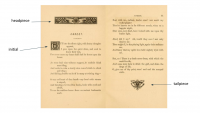
There are many different types of printer’s ornaments, the most common being headpieces, tailpieces, and initials that are found on page tops, page bottoms, and section headings, respectively (see Fig. 1). Printer’s ornaments served a wide variety of purposes for both form and function. They added beauty and color to otherwise black text, and some even provided information towards understanding the text. Printers could use printer's ornaments to reproduce and highlight the author's own doodles or typographical elements, giving a sense of authority or active engagement from the author to their text [5]. On a more practical note, printer’s ornaments provided support in empty spaces within a printing frame, thereby preventing warping or distortion of paper and ensuring a certain quality of print [1]. Moreover, some printer’s ornaments were accompanied by information about the printer, location, and year in which the text was printed [6].
As printing entered the digital age, printer’s ornaments lost their practical, page-holding purposes and are now relatively obsolete. However, historical remnants of printer’s ornaments exist within volumes such as Album de stampine antiche and Henry Plomer’s English Printers’ Ornaments. These two volumes represent two very different perspectives on “collecting” and “reading” printer’s ornaments, especially since they demonstrate a trend in printer’s ornaments from aesthetic visuals to scholarly resources in different time periods. Moreover, the portability—both physical and meaningful—of printer’s ornaments can be explored through a brief study of a reoccurring printer’s ornament depicting a bear-hunting scene, with this particular ornament present in both Album and English Printers’ Ornaments and how this particular ornament was presented in these volumes.
Album de stampine antiche
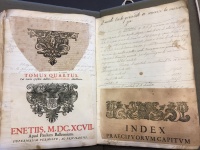
The Album de stampine antiche (or “Antique stamps album”) is a phenomenal example of a compilation of printer’s ornaments. Created during the nineteenth century in Florence, Italy, Album is a scrapbook that contains hundreds of cutouts from books, featuring over 350 different kinds of printer’s ornaments. The creator of Album has remained unknown; however, it is believed that someone in the Peruzzi family was involved, seeing as there are many instances of a “Caroli Peruzzi” leaving his signature within the book [7]. The printer’s ornaments featured are all from books published between the mid-sixteenth to late-eighteenth centuries, thereby demonstrating the longevity of printer’s ornaments during the time [8]. These printer’s ornaments are especially unique because they are all cutouts, specimens of original pieces from books (as opposed to reproductions or scans). Additionally, Album is not a book solely dedicated to printer’s ornaments; the scrapbook element comes from the fact that these cutouts were pasted on top of a book that was previously used for business transactions of a sort, a nod towards the possibility of the Peruzzi family being involved in the creation of Album as they were a prominent banking family at the time (see Fig. 2). The juxtaposition of calligraphic text against bold images is quite vivid and highlights the scrapbook elements of Album quite well.
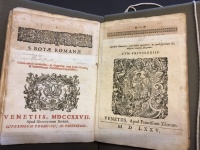
Another notable physical feature of Album includes its composition of printer’s ornaments which highlights the creator's choices. Many of the printer’s ornaments were cut from title pages, and whoever cut them out also included surrounding printed information on the title, publisher, and location and date of production as well. While most locations were domestic—Venice, Rome, Florence, for instance—others were international—take Geneva, Lyon—thus demonstrating how book production and circulation was widespread throughout Europe at the time. From a purely syntax perspective, printer's ornaments only refer to the images themselves (and not the the words), so the fact that the creator decided to cut out these additional snippets speaks to the idea of aesthetics in identification, as if the printer's ornaments themselves "lose" meaning without the titles, locations, or dates.
Similarly, Album is not arranged in any particular order; similar printer's ornaments (or identical ones, as indicated below) are not grouped together, and the printer's ornaments themselves are pasted in a rather haphazard manner across the volume. This obviously points more towards the creator of Album and their perspective on printer's ornaments; by opting to paste the printer's ornaments randomly throughout the book, the creator demonstrates some sort of urgency in their actions. In this case, they pay more attention towards the act of preserving the printer's ornaments as opposed to organizing them in some pattern.
In many ways, Album goes directly against the idea of printer’s ornaments as enhancing text because the book is almost solely made up of these cutouts, with the existing text having little to no relation to the images themselves. Similarly, the fact that these cutouts were pasted over a used book and not a blank book indicates some sort of connection or discrepancy in the value of text versus images, as if the creator thought that the cutouts themselves may not have been worth pasting into a new book but were somehow still more significant than the words written on the pages. Although there is a possibility that the cost of paper (or producing books) played a role in the creator’s decision to create Album out of a used book, this does not excuse the fact that this shows how people placed different sorts of significance and importance upon books, leading to the expendability of books (and their contents) at that time. In today’s society, most books are maintained in their original form, yet the fact that someone could so brazenly cut up a book just to remove its decorative elements—printer’s ornaments, in this case—is a concept that may seem foreign to most of us.
With regards to the balance and the relationship between reading and writing, Album demonstrates how these two concepts were heavily skewed, especially with the fact that the printer's ornaments were the only artifacts preserved by the creator from the books of the time. The production cost of writing (including publishing and production) is relatively higher compared to that of reading (simply opening a book), but this cost is not reciprocated by the creator of Album as evidenced by their rather careless handling of their books (from which they removed printer's ornaments). Interestingly enough, the cutout nature of Album also speaks towards a culture that is heavily dependent and concerned with appearances and aesthetics, especially from a visual perspective. The lack of text featured in Album points to a society that was very much concerned with the appearance and beauty of books rather than their textual contents. In fact, the very action of cutting out printer's ornaments from books and pasting them over text in another book implies some sort of importance of preserving the art rather than the words.
Album also hints at some possible social and economic implications with how books were disseminated across the population. Given the relatively high cost of books in that time, only the rich or well-connected would have access to books, with wealthy families—such as the Peruzzis—being able to have access to many books—as evidenced by the magnitude of varied cutouts in Album—while others may not have had the same opportunity to do so.
English Printers' Ornaments
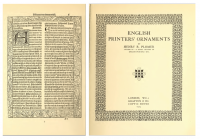
Several hundred years later and many kilometers away, Henry Robert Plomer published his book English Printers’ Ornaments, a volume dedicated to printer’s ornaments of the English variety. An English biographer and bibliographer himself, Plomer focused and specialized in printing and bookselling, and his works reflect that sentiment. This particular edition of English Printers’ Ornaments was published in 1924 with a limited run of 500 copies. Throughout the first part of the volume, Plomer goes in depth about the origins of printer’s ornaments as well as the different types of printer’s ornaments, adding explanations to specific examples of ornaments and the printers who used them. In the second part of the volume, Plomer includes a section devoted entirely to printer’s ornaments, divided up by type (headpieces, tailpieces, etc.) and printed only on one side of the page. The book itself is very unique, with many of the pages having uneven page widths and wide margins running along the outside and bottom edges.
English Printers’ Ornaments is a classic example of a structured collection. The interaction between the book and printer’s ornaments is also very clear—the title page and its ornaments are arranged in the format that is reminiscent of older books, with the title, the publisher, and the location and date of production printed out. On the opposite page, there is also an example of an old text featuring printer’s ornaments (specifically borders and initials), which almost functions as a frontispiece of sorts to inform the reader of the content in the book (see Fig. 4).
In making English Printers’ Ornaments, Plomer was able to showcase a myriad of different printer’s ornaments but with one specific restriction: all of the printer’s ornaments he chose were what he considered to be English printer’s ornaments. Although there is evidence that some printer’s ornaments may have had origins elsewhere (see below), the idea that all of the ornaments featured in the volume are English in nature is a huge stretch, considering the fact that many other areas of Europe were also using printer’s ornaments at the time and that designs could have been easily traded or translocated to different areas around Europe. Moreover, the idea of an “English printer’s ornament” raises many questions: does Plomer mean that the printer’s ornament specifically originated in England? Or does he mean that the printer’s ornament has “English” characteristics in its design? These are questions that should be considered when thinking about what “English printer’s ornaments” even means in a broader context.

Although Plomer demonstrates a high level of knowledge and appreciation for printer’s ornaments by highlighting specific examples and explaining his ideas on their development, he interacts with them in a way that contradicts their intended purpose. For instance, Plomer displays the printer’s ornaments in a section by themselves separate from his textual analysis, clearly going against earlier functions of printer’s ornaments as surrounding and supporting the text. This separation may show how Plomer has personal bias in the significance of printer’s ornaments versus text and how he might think that the two should be interpreted on their own terms (as opposed to being compared alongside one another). Another odd aspect to English Printer’s Ornaments is in the lack of organization of the printer’s ornaments in the index. Although Plomer does number the printer’s ornaments and includes their source, printer, and year, the printer’s ornaments themselves aren’t arranged in a conventional manner (for instance, chronologically), thus leading to even more confusion on readers who may want to establish a perspective on how printer’s ornaments developed throughout the years (see Fig. 5).
When used to explain the connection between reading and writing, English Printers’ Ornaments demonstrates a disjointed relationship between the two. Although the volume has both “writing” (Plomer wrote this) and “reading” (readers can read it) aspects, the separation of printer’s ornaments and text creates a rift between these two processes. Since printer’s ornaments do not necessarily have any intrinsic “reading” value to them, the addition of textual explanations points to an aspect of society that yearns to explain and understand why things—in this case, printer’s ornaments—exist and how they function. Unfortunately, since the printer’s ornaments are not placed alongside their textual discourse counterparts, it is fairly difficult to negotiate and navigate this physical separation when observing and using the volume.
In considering how English Printers’ Ornaments represents the importance of books in twentieth-century England, we can see that printer’s ornaments have transitioned in function from printing devices to collectable pieces. The analytical and organizational aspects of English Printers’ Ornaments also point towards Plomer’s perspective of creating books to be analyzed and discussed in a scholarly manner. Through his analysis, Plomer also demonstrates the development of printer’s ornaments from something that functions in the production of a book to something that should be studied in a book. In English Printers’ Ornaments, the balance of text and printer’s ornaments also alludes to a society that was very much immersed in the idea of reading on writing technologies as an academic topic, thus revealing an interesting connection between the two. Moreover, the fact that the book was printed shows how book production was a mainstay in society at the time. Thus, the social and economic implications with regards to the development and spread of books across a population became more widespread across demographics at the time.
Further Interpretations
So why should we care about printer’s ornaments? And what do these two volumes even have in common? Another method in considering the effects of printer’s ornaments on book technology is to compare and contrast Album de stampine antiche and English Printers’ Ornaments. For instance, the difference in presentation of printer’s ornaments in both volumes speaks to two radically different approaches towards the idea of collection and interpretation. In Album, printer’s ornaments are portrayed as being purely visual and superfluous objects, and the collecting perspective is built upon an impulse to cut and paste (especially considering the repeating or reoccurring printer’s ornaments throughout the volume). This shows how the creator of Album is solely concerned with “keeping” printer’s ornaments for their beauty and artistic value. On the other hand, Plomer’s English Printers’ Ornaments demonstrates how Plomer approached collection in a very deliberate manner for a specific purpose: showcasing what he deemed to be “English” printer’s ornaments. Moreover, Plomer’s organization of the book (separating textual analysis from the printer’s ornaments themselves) shows a certain level of care and attention to detail that has been placed in interpreting and presenting the printer’s ornaments—a far cry from the jumbled pastings of Album.
Another comparison between Album and English Printer’s Ornaments reveals a trend in printer’s ornaments from aesthetic artifacts to scholarly pieces. With Album, there is only one copy, and this copy is haphazardly pasted over another used book. This sense of instant gratification (from being able to immediately collect and display printer’s ornaments) is echoed throughout the volume. However, Plomer’s English Printers’ Ornaments was first published in a limited run of 500 copies. By publishing an entire volume on printer’s ornaments in a limited quantity, Plomer is demonstrating how his volume is meant to be read by a very specific and relatively small audience. The scholarly format and analysis in English Printers’ Ornaments point to this audience as being perhaps from a university or a research institution, thereby solidifying Plomer’s desire for English Printers’ Ornaments to be read in terms of its “usefulness” or to its use for research purposes by a specific audience.
A Peculiar Sleuth of Bears
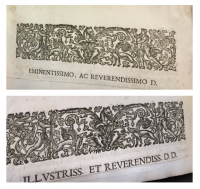
Throughout my research into printer’s ornaments, I discovered a very interesting printer’s ornament that appeared in both Album and English Printers’ Ornaments. This particular ornament is a headpiece that features a bear, two dogs, two snakes, and two men within dense foliage (see Fig. 6 below). Within Album, this particular ornament appears many times in different contexts; one such version includes the words “eminentissimo, ac reverendissimo d” (roughly translated to “the most lofty, and the most revered”), while another version says “illvstriss. et reverendiss. d. d.” (roughly translated to “illustrious, and revered”) (See Fig. 7). Although there is no background on this particular headpiece in Album, it can be inferred from the words used alongside the headpiece that the printer’s ornament was used to denote something biblical or religious.
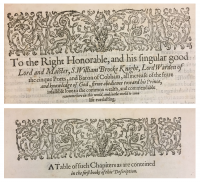
Interestingly enough, the same printer’s ornament is featured in English Printer’s Ornaments as a headpiece from Holinshed’s Chronicles, appearing in 1587 (although Chronicles was first printed in 1557) [9]. However, in some instances, the bear is facing the other way. This demonstrates that although the bear ornament was widely used, it was probably also widely copied and reproduced by several different printers. In Chronicles, the headpiece is featured atop a dedication letter to a S. William Brooke Knight and also above a table of contents (see Fig. 8). Since this particular headpiece was used to denote headings or regalia of a sort (as evidenced by the dedication letter), one can surmise that the printer’s ornament was used to recognize something or someone of royalty or power. There is some overlap between the time period of the printer’s ornaments featured in Album and when Holinshed’s Chronicles was first published, so it can be reasoned that the same printer’s ornament may have travelled throughout Europe, though the lack of publishing information on the ornaments from Album may make this hard to determine. Moreover, since this particular headpiece was used to denote importance—in both religious and sovereign contexts—the bear ornament may have been especially reserved to emphasize the power and reach within specific texts or used for some historical significance.
Additional research into the bear ornament yields a fascinating trove of information. For instance, the original printer’s ornament used in Holinshed’s Chronicles was reproduced and used in Madrid [9]. This also speaks to the movement and transferring of materials (especially printer’s ornaments) between different printing presses, highlighting the fluidity in exchanging printer’s ornaments. Additionally, the bear ornament and its many individual components (the bear alone as an ornament, the hounds and men alone as an ornament) appear in several Hebrew books, often used in title pages or as headpieces. Although information on these particular printers has yet to be validated, it is clear that this particular bear ornament was used in a wide variety of books and texts and played a prominent role in Hebrew printing presses for over a century.
Curiously, the bear ornament did not surface in Hebrew texts until the mid-fifteenth century, when Jewish printers would borrow or arrange to use printing presses from Christian printers (in Italy, Jews were not allowed to own their own printing presses) [9]. Through the mobility of the bear ornament, we can see that printer’s ornaments are not mere tools for printing; they have a rich history that moves across regions (especially in Europe), and their movement demonstrates an appreciation of beauty and aesthetics from people of different demographics regardless of background. The collective recognition of the bear ornament as a decorative and beautiful piece by Jewish and Christian printers alike shows that people recognized printer’s ornaments not just as mere tools, but as instruments of allure and attraction as well.

Final Thoughts

In conclusion, printer’s ornaments today are largely defunct, yet their legacy is passed on through scholarly analysis of images within books. For instance, the analysis performed on these texts—such as Album de stampine antiche and Plomer’s English Printers’ Ornaments—yields a rich, intercontinental history of printer’s ornaments that is supplemented by the evidence of their movement and permanence in history. Moreover, printer’s ornaments may have some permanence, especially in today’s day and age. One such extension is in the usage of emojis in modern communication as a form of conveying emotions and ideas though images or as a way to fill in blank space. Though emojis do not necessarily have a specific function that is analogous to that of printer’s ornaments in printing technology, emojis are used and read by a wide demographic of people as to have meaning. In some instances, emojis can be used to emphasize certain phrases or words while surrounding the text (see Fig. 9). Different people may use the same emojis to imply different emotions or different thoughts, similar to how printer’s ornaments do not have a single ascribed meaning to each individual ornament (as evidenced by the bear ornament). So, although what we consider to be “printer’s ornaments” may have vanished from popular media, remnants of their function and power still remain.
And yet, all of this comes back to the fundamental idea of books and their ability to move, thereby showing how literacy and knowledge were able to spread across nations, and eventually, the world.
Notes
- ↑ 1.0 1.1 1.2 Plomer, Henry R. English Printers’ Ornaments. Grafton & Co. Coptic House, 1914. (digitizing sponsored by York University—University of Toronto Libraries)
- ↑ Reilly, Elizabeth Carroll. A dictionary of colonial American printer’s ornaments and illustrations. American Antiquarian Society, 1975.
- ↑ “Printers Ornaments.” BiblioOdyssey, 6 Apr. 2008, bibliodyssey.blogspot.com/2008/04/printers-ornaments.html
- ↑ A Database of Eighteenth-Century Printers’ Ornaments. Fleuron: A Database of Eighteenth-Century Printers’ Ornaments, fleuron.lib.cam.ac.uk/index.
- ↑ Flint, Christopher. "In Other Words: Eighteenth-Century Authorship and the Ornaments of Print." Eighteenth-Century Fiction. Vol. 14, No. 3-4, pp. 625-672. University of Toronto Press, 2002.
- ↑ Creel, Sarah, “(Re)framing Eliza Haywood: Portraiture, Printer’s Ornaments, and the Fashioning of Female Authorship.” Journal for Early Modern Cultural Studies. Vol. 14., No. 4, University of Pennsylvania Press, 2014.
- ↑ Album de stampine antiche, Ms. Codex 1859, Kislak Center for Special Collections, Rare Books and Manuscripts, University of Pennsylvania.
- ↑ “Album de stampine antiche.” University of Pennsylvania Finding Aids, http://dla.library.upenn.edu/cocoon/dla/ead/ead.html?start=25&id=EAD_upenn_rbml_PUSpMsCodex1859&.
- ↑ 9.0 9.1 9.2 Heller, Marvin J. “The Bear Motif in Seventeenth- and Eighteenth-century Hebrew Books.” The Papers of the Bibliographical Society of America. Vol. 102, pp.341-361, Bibliographical Society of America, 2008.